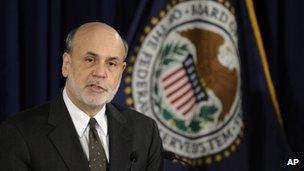Risks to financial system of interest rate rises
- Published
- comments

The central banks' central bank, the Bank for International Settlements, has given a graphic warning of the havoc that could be wreaked if the Fed or the Bank of England (among other central banks) were to end and reverse their massive money creation in a cack-handed way.
Its annual report may also give pause for thought to the British government and opposition on the scale and nature of long-term public expenditure cuts, just two days ahead of the unveiling by the Chancellor George Osborne of his spending review.
The BIS points out that in many rich developed economies, the interest rate or yield on 10-year government debt was 6% on average for the 20 years before the 2008 crash and the associated debut of unprecedented monetary easing.
Now for much of the current era of quantitative easing and record low interest rates, the equivalent interest rate in the UK, United States, Switzerland and Germany has been 2% or less - and even after recent turmoil in bond markets, the rate is still nearer 2% than 3% in the UK and US.
Japan, as a special case of long-term crippling deflation, has had low interest rates for longer, of course.
Now with the US Federal Reserve signalling the possible phased ending of its $85bn a month of money creation through bond purchases from the autumn to the middle of next year, it is not unreasonable for the BIS to ask what might happen if such a policy change led bond prices to fall even more sharply than they have in recent weeks.
It investigates the impact of a fall that pushed up the implicit yield or interest rate on 10-year debt, 10-year bonds, by three percentage points.
That would be a big leap. But it is not an inconceivable shift, given historic interest rates. And it could happen quite fast. In 1994, bond yields rose two percentage points in a single year.
If that happened just in US Treasury bonds, the loss for investors - excluding the bond holdings of the Federal Reserve - would be more than $1tn, or about 8% of GDP.
And if there were associated falls in the prices of bonds issued by France, Italy, Japan and the UK, the losses would range from 15% to 35% of GDP of those countries, respectively.
The loss for investors in UK gilts, for example - excluding the holding of the Bank of England - would be more than a quarter of UK GDP.
Ouch.
As the BIS says, many investors have already hedged or insured their positions against such a price drop. But all that means is that the loss has been passed to their insurers. (I don't mean insurance companies, I just mean those on the other end of the hedge - which of course might be insurance companies.)
The pain of such a sharp shift in bond prices can't be magicked away.
To put this in the BIS's words, "as foreign and domestic banks would be among those experiencing the losses, interest rate increases pose risks to the stability of the financial system if not executed with great care".
And even if there isn't another banking meltdown, the long-term savings - the pensions - of millions of people would be mullered.
Or to express this another way, the very money-creation policy designed to ease our post-crash economic pain has created the conditions for another financial crisis.

Ben Bernanke said any interest rate rise was likely to be "far in the future"
No wonder there have been such market jitters since Ben Bernanke at the Fed started talking out loud about how money might not be quite so cheap before too long.
Which brings us to the BIS's great sadness, as it were. The countries engaging in all this seemingly necessary but dangerous money creation have not - in the BIS's view - been using the respite granted them productively enough.
Or to put this another way, money creation was justifiable - in the BIS's view, and that of many governments, including Britain's - to lessen the impact on short-term prosperity of public spending cuts and tax rises needed to reduce governments' excessive deficits.
However. the BIS doesn't believe rich developed countries have done an effective enough job in cutting deficits during the years of grace given them by quantitative easing.
And, if you share the BIS's view that quantitative easing can only be temporary and that big deficits are economically and financially toxic for the long term, then the picture it paints of the UK is particularly troubling.
Here is a discordant quartet of financial and fiscal statistics about the UK.
First, its overall indebtedness - that is the sum of government, corporate and household debt - has risen by more than 60% of GDP since 2007, largely because of the increase in government debt.
That is the third biggest rise in indebtedness, on a proportionate basis, of any of the world's 18 largest economies.
And it has occurred at a time when most would say it would be sensible to lessen the debt burden on an economy like ours.
So what has been the impact of austerity in the UK, of spending cuts and tax rises, on the deficit and on the annual increment to the government's overall indebtedness?
Well, there has been a cut in the "underlying government primary deficit" - or the deficit excluding interest charges - from 7.6% of GDP in 2009 to 4.3% of GDP in 2013.

Ring-fenced funding may be at risk
So there has been a reduction in the rate of increase in the government's debts.
But there has been a smaller reduction in Britain than in any other of the fiscally challenged economies: much smaller than in Greece, or Ireland or Italy for example, and smaller even than what's happened in the US.
Here's the implication that may bring tears to the eyes of hardened politicians: to reduce the ratio of British public sector debt to GDP back to about 60% by 2040 (on the BIS's measure it is currently above 100%) would require spending cuts and tax rises on a scale we haven't yet experienced.
Only the US and Japan would have to endure similar pain.
By the way, there is nothing mystical about a 60% debt-to-GDP ratio, although it is the level most economies have regarded as the sensible sustainable ratio in recent years (it is enshrined in the EU's Maastricht Treaty for example).
Nor is this a rogue result. The OECD recently published a very similar projection of the scale of the potential future squeeze needed in the UK.
As for the nature of the supposedly necessary cuts that the BIS implies will become a way of life in the UK for many years yet, it calculates that age-related healthcare spending is rising at a faster rate in the UK than in any other big economy apart from the US.
Which may imply that the ring-fencing of health spending in Britain won't and can't survive the next general election.